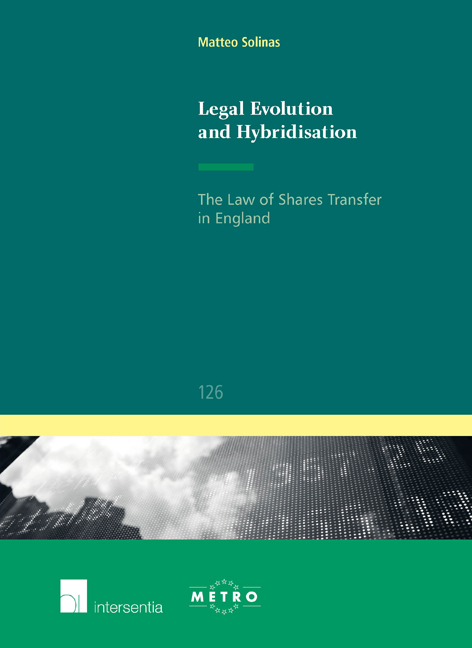Book contents
- Frontmatter
- Foreword
- Preface
- Acknowledgements
- Contents
- Table of Cases
- Introduction
- PART I THE IDEA OF HYBRIDITY IN COMPARATIVE LAW
- PART II THE CIRCULATION OF SHARES
- Introduction to Part II
- Chapter 4 The Transfer of Registered Shares
- Chapter 5 The Transfer of Share Warrants to Bearer
- Summary of Part II
- PART III THE TRANSFER OF (INTERESTS IN) SHARES
- Summary of Part III
- Conclusions
- Bibliography
- IUS COMMUNE EUROPAEUM
Chapter 4 - The Transfer of Registered Shares
from PART II - THE CIRCULATION OF SHARES
Published online by Cambridge University Press: 22 November 2017
- Frontmatter
- Foreword
- Preface
- Acknowledgements
- Contents
- Table of Cases
- Introduction
- PART I THE IDEA OF HYBRIDITY IN COMPARATIVE LAW
- PART II THE CIRCULATION OF SHARES
- Introduction to Part II
- Chapter 4 The Transfer of Registered Shares
- Chapter 5 The Transfer of Share Warrants to Bearer
- Summary of Part II
- PART III THE TRANSFER OF (INTERESTS IN) SHARES
- Summary of Part III
- Conclusions
- Bibliography
- IUS COMMUNE EUROPAEUM
Summary
The conventional view is that the genealogy of the modern English limited liability company (and the mechanism of transfer of registered shares) has its roots in the scheme of the partnership and of the unincorporated joint stock company formed by contract or under a deed of settlement. This view identifies an important thread in explaining the history of the current legal framework and highlights the relevance of legal tradition in shaping legal change. It is suggested in this chapter that this view offers, however, a partial representation of the process of legal evolution. This is done in three steps. Section 1 presents the founding elements and characteristics underlying the modern law of registered shares. Section 2 sets out the orthodox interpretation of the immediate genealogy of the modern English company and of the techniques of transfer of membership. Building on this analysis, section 3 argues that the current legal characterisation of the circulation of registered shares has been shaped to a significant extent by legal borrowing from the Genoese model of maritime partnership (the societas maris) employed for part-ownership in ships in England starting from the seventeenth century. It also argues that the reception of that scheme did not occur in its original form, but that it was adapted through a process of hybridisation in accordance with the indigenous fellowship traditions of the guilds.
The Current Legal Framework
The paragraphs below set the boundaries and identify the subject matter of the inquiry. The investigation focuses on the legal nature and the (possible) physical manifestation of registered shares, establishing how legal title is transferred (sections 1.1 and 1.2).
Although this necessarily involves separate studies of the law of certificated and uncertificated shares (section 1.3), the underlying legal characterisation of the nature of the transfer in terms of novation remains identical (section 1.4). Finally, some attention is dedicated to the ‘bona fide purchaser’ defence as a fundamental rule for understanding the nature of transactions related to registered shares (section 1.5). This specific issue will be discussed again in Part III when comparing it with the protection available for innocent purchasers of intermediated shares.
Legal Nature
In order to describe how registered shares are transferred it is first necessary to establish what shares are and, in particular, what their legal nature is. The Companies Act 2006 states that shares are personal property.
- Type
- Chapter
- Information
- Legal Evolution and Hybridisation , pp. 51 - 108Publisher: IntersentiaPrint publication year: 2014



